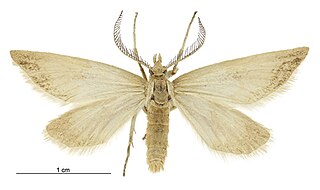
Ball's Pyramid is an uninhabited islet in the Pacific Ocean located 20 kilometres (12 mi) southeast of Lord Howe Island. The steep rocky basalt outcrop is the eroded plug of a shield volcano and caldera that formed 6.4 million years ago. It is 572 metres (1,877 ft) high, while measuring 1,100 metres (3,609 ft) in length and only 300 metres (984 ft) across, making it the tallest volcanic stack in the world.

The New Zealand plover is a species of shorebird found only in certain areas of New Zealand. It is also called the New Zealand dotterel or red-breasted dotterel, and its Māori names include tūturiwhatu, pukunui, and kūkuruatu.

Cochranella is a genus of glass frogs, family Centrolenidae. They are found in Central America from Honduras southward to the Amazonian and Andean cloud forests of Colombia, Ecuador, Peru, and Bolivia.

The rufous bristlebird is one of three extant species of bristlebirds. It is endemic to Australia where three subspecies have been described from coastal southwestern Western Australia, southeastern South Australia and southwestern Victoria. Its natural habitat is coastal shrublands and heathlands. It is threatened by habitat destruction.

Wallace's fairywren is a species of bird in the Australasian wren family, Maluridae. It is the only species within the genus Sipodotus. It is found in New Guinea and the Aru Islands, where its natural habitat is subtropical or tropical moist lowland forests.
Diadegma agens is a wasp first described by Henry Keith Townes, Jr. in 1964. No subspecies are listed.

Antiscopa epicomia is a moth in the family Crambidae. This species was first described by Edward Meyrick. It is endemic to New Zealand and can be found throughout the country including on Auckland Island, Campbell Island, and the Kermadec Islands. It inhabits native forest, preferring damp, shaded forest ravines. Adults are variable in size and colouration and are on the wing all year but most frequently from October until March.

Asaphodes campbellensis is a species of moth in the family Geometridae. It is endemic to Campbell Island in New Zealand.

Friesea is a large genus of springtails belonging to the family Neanuridae.

Asaphodes oxyptera is a species of moth in the family Geometridae. This species is endemic to New Zealand and is only found in the Auckland Islands.
John Tenison Salmon was a New Zealand photographer, entomologist, academic, conservationist, and author. His primary occupation was as an entomologist; first at the Dominion Museum and then at Victoria University College.

Keith Arthur John Wise, often referred to as K. A. J. Wise, was a New Zealand entomologist. Originally employed at the Department of Scientific and Industrial Research, Wise began working with the Bishop Museum in the early 1960s, coordinating field programmes for United States visits to Antarctica and Subantarctic islands. This work led Wise to identify and describe large numbers of novel species, including many species of springtail. In 1965, Wise became the first Curator of Entomology at the Auckland War Memorial Museum, where he was integral in creating the first entomology section within the natural history gallery.

Acanthomurus rivalis is a species of springtail belonging to the family Isotomidae. The species was first described by Keith Arthur John Wise in 1964. The species is native to Campbell Island in the New Zealand Subantarctic Islands.
Alloecentrella is a genus of caddisflies belonging to the order Trichoptera. The genus was first recognised by Keith Arthur John Wise in 1958.

Cryptopygus campbellensis is a species of springtail belonging to the family Isotomidae. The species was first described by Keith Arthur John Wise in 1964. The species is native to Campbell Island in the New Zealand Subantarctic Islands.

Parakatianna salmoni is a species of springtail belonging to the family Katiannidae. The species was first described by Keith Arthur John Wise in 1964. The species is native to Campbell Island in the New Zealand Subantarctic Islands.
Cryptopygus cisantarcticus is a species of springtail belonging to the family Isotomidae. The species was first described by Keith Arthur John Wise in 1967. The species is native to the Cape Hallett area of Northern Victoria Land in East Antarctica and the surrounding offshore islands, including the Balleny Islands.
Cryptopygus terranovus is a species of springtail belonging to the family Isotomidae. The species was first described by Keith Arthur John Wise in 1967.
Tullbergia mediantarctica is a species of springtail belonging to the family Tullbergiidae. The species was first described by Keith Arthur John Wise in 1967, and is only known to occur around the Shackleton Glacier area.













